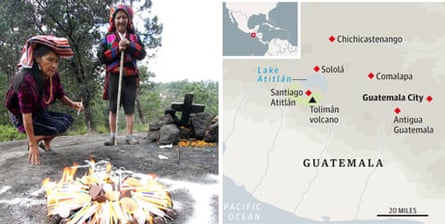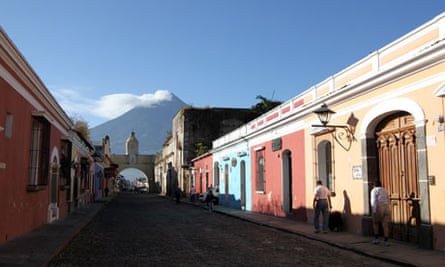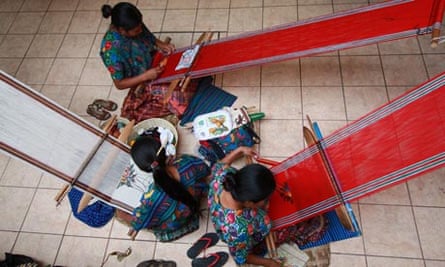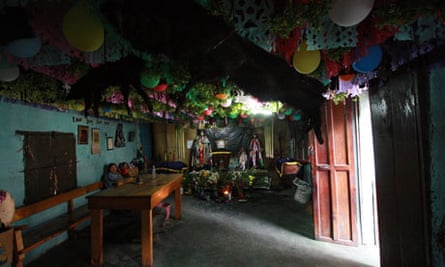On top of the hill the old man and his wife were standing next to the altar they had made, muttering words into the smoke. The dogs that had been fighting in the bushes had gone and the raucous rock music that had been pulsating from the town a mile away had mercifully stopped. There was a moment of total peace and tranquillity.
Two black vultures suddenly broke from the horizon of trees and wheeled low over our heads. The old woman knelt down and kissed the earth while the old man kept on chanting, in a strange guttural language full of creaks and hisses. If languages can sound like the lands they inhabit, this one seemed perfectly attuned to the volcanoes, cloud forests and ruined temples of Guatemala.
This is as close as one can get, I thought to myself, to pre-Columbian America. I had a vision of priests in feathered gowns standing on high stone platforms and sacrificing human beings to the sun god. Then the old man rummaged in his pocket and took out not a deadly jade dagger but a bottle of Coca-Cola. He took several gulps and then carried on chanting.
We were on top of Pascual hill, near the Guatemalan town of Chichicastenango, Chichi to its residents, and I was with Don Diego, a Mayan ajq'ij, a word often translated as shaman but literally "day-keeper". The Mayans are a people much interested in time and number. They count in 20s, a human-size unit – all the fingers and toes – which they multiply by the number of major joints in the body – 13 – to make 260. Long ago they noted that the planet Venus moved from being an evening to a morning star in 260 days, the same time it takes to grow a crop of maize and to complete a human pregnancy.

From this basis, and the solar year, they linked humanity with the heavens and built a calendar of minute precision, and also of epic size. It runs in short cycles of about 20 years (or katuns, of which 13 make one may – hence Maya, people of the may) and longer ones of more than 5,000 years. One of these long cycles is due to end on 21 December 2012, a fact that has led some people to claim that the Mayans have predicted the End of the World. I'd come to Guatemala to investigate – as good a place as any to spend some of my limited time on earth.
The ceremony on the hill was over. Don Diego and his wife, Juana, walked slowly down the hill to their house, where they showed me a room full of masks. In the corner was a shrine to Guatemala's home-grown deity, Maximón, a strange syncretic god who manages to combine the apparently contradictory aspects of ancient Mayan deity and Marlboro Man. His image is that of a cowboy: Stetson on his head, cigarette forever on his lip and Coca-Cola close to hand. But looking closer I could see jungle fruits too, vestments in hammocks and skins of animals. This was a god who drinks and smokes and needs placating. My guide, Rita, leaned over and whispered: "He will do bad things for you, if you ask correctly." She grinned. "Really. Lots of people come for that.'
The Mayans have had to survive for a long time as underdogs and they have done it by accommodation. When the Spanish came in 1523, plotting total cultural destruction, the indigenous people (Mayan is a catch-all term for several related languages and peoples) responded with guile. Images of Catholic saints were stuffed with old Mayan gods; parts of temples were incorporated into churches; at Nuestra Señora de la Merced in Antigua Guatemala you can see how Mayan masons carved symbols of maize and hummingbirds into the church facade.

The persecution did not end with independence, because in the Americas independence was for the colonials not the colonised – it meant nothing for any indigenous person, Arawak to Zapotec. In Guatemala persecution of the Maya continued: an estimated 60,000 died in the army's genocidal campaigns of the early 1980s under President Efraín Ríos Montt. (The man whom Ronald Reagan described as having "integrity" still sits in the country's congress.) Mayan languages were outlawed and cultural practices vilified and suppressed. Fortunately these nightmares have ended and now, on the eve of their new era, it seems that the Maya might have a chance of a renaissance.
In the small town of Comalapa to the south, the Tuesday market is filled with Mayan women in boldly coloured, home-woven clothes, all speaking Cakchiquel, one of the main Mayan languages. But rising above the chatter of the crowds is another noise: the amplified sound of rocked-up cheesy Christmas songs. I asked a local man what it was. "That's the evangelical church," he said, without much enthusiasm. I gathered he was not one of them. "They do it every market day – to remind us they are here."
I followed the noise and wandered through the open doors. The church was full of children in fancy dress, all singing their hearts out. The evangelical movement is growing at a phenomenal pace in Guatemala, having hit upon a simple message: join us, get rich. God, it seems, loves sinners, but most of all he loves people who embrace a full Yankee lifestyle and give 10% to the pastor. Unfortunately most of these churches also demand a total rejection of Mayan traditions.
From Comalapa I headed east towards Lake Atitlán. It was raining when we got to Sololá, a town on a hill overlooking a collapsed water-filled volcanic crater. There were no tourists in Sololá – it's too far from the water – but the vibrant market was superb. Women's costumes were very different from those in Comalapa, and many men wore Mayan dress, too: colourful patchwork trousers and shirts, cowboy hats and dark woollen sarong/apron affairs – a Vivienne Wild Westwood look.
There are villages all round the lake and, bizarrely, each has a very different character. I was heading for Santiago Atitlán, on a narrow bay reached by boat on the south side of the lake, in the shadow of the 3,156m Tolimán volcano. There was something here that Rita was very keen I should see.
"There's a shrine to Maximón. Actually, there are two: one is a tourist rip-off, no more than a business to take money off visitors. The other is genuine."
We disembarked and strolled up the village's main drag, an assault of craftwork and weaving: Mayan fingers are so nifty and productive that in most markets I'd have to scoot through at double-quick pace. Everything is so well-conceived, well-made and superbly finished – the Mayans have turned creativity into pure shopping addiction, handicraft crack-cocaine. I just couldn't add any more wonderfully attractive cloths or exquisitely sculpted wooden artefacts to my bag without risking irreparable spinal damage.

Rita bustled me away down a dark narrow alleyway. As we followed its twists and turns, she tried to explain how the shrines used to work. "There is a system of cofradías [brotherhoods] in the town and each of them has an image of Maximón. Every year someone from the cofradía will display the figure in their house – it's a big sacrifice, as these are people who might only have two rooms and the Maximón needs his own."
A man in a straw cowboy hat squeezed past us. The alleyway appeared to be petering out into little more than a concrete crevice. "They get benefits of course: once a year they wash Maximón's clothes and the dirty water is bottled up and sold."
"Sounds like a good money-spinner."
We waited while a woman in a traditional handwoven blouse with skirt and frilly apron went past with a basket on her head.
"It used to be," agreed Rita. "But now the number of people has fallen off. There used to be more than a dozen cofradías with shrines here in this one village. Now there is just one – plus the tourist one, which is a fake."
We had come to a dilapidated gate that opened into a beaten-earth courtyard where three sorry-looking chickens were pecking each other in the mud. A small child stared up at us.
"This is it." We went into the courtyard and Rita called out until a woman appeared. She led us to a room away from the main house. As I entered I banged my head on something and stopped dead in my tracks. The thing that I had walked into was a flying pig: a stuffed wild boar, black as night, flying in a ceiling of bright paper bunting and balloons. There were other animals up there too: strange New World creatures that I did not recognise, jungle cats, monkeys and more pigs, all stained black with incense smoke. At the back of the room was a stack of deerskins and other body parts, long since dried.
Then I saw the altar. Two large wooden figures, rather saintlike, stood next to other smaller figures in a sea of flowers and incense sticks and candles.
"Is that Maximón?" I asked.
Rita shook her head. "That's Saint John and that …" she raised an eyebrow, preparing me for a shock, " … is Judas Iscariot."
She pointed down among the flowers and candles. Only then did I see the dark cowboy hat and the carved head with its cigarette, a silk scarf loosely knotted around its throat. "That is Maximón."
We stood there for quite some time. I put some money in Saint John's hand. There was a hole in his mouth where rum could be poured in. But Maximón was the dominant presence, from down there near the floor, hiding behind the flowers, the curious amalgam of good and evil, of John and Iscariot, who must be supplicated, entreated and cajoled. I could see why the Spanish friars had reacted badly when they discovered what the Maya had done with their saints – turning them into complex spirits prone to bouts of generosity and of perverse vindictiveness.

In 1562 in the Mexican village of Maní, Spanish bishop Diego de Landa discovered that the local Maya were worshipping their old gods in the guise of Christianity. In righteous fury he had 4,500 peasants tortured in the town square, 158 of them to death. It was a rage that confirmed everything the Maya feared about their overlords. Rebellion was a long time coming, but the Maya have no fear of time. In 1847 they rebelled and established the Mayan state of Quintana Roo on the Yucatan peninsula, an unrecognised nation that survived until the invention of the machine gun.
I stepped away from the shrine. We had been there for 30 minutes and nobody else had come. Back in the alley Rita admitted that it was quiet these days.
"The evangelical churches are attracting people away in huge numbers. The whole Maximón religion may soon die out." We had reached the end of the alleyway and were looking out at the street. "People say that the CIA brought the evangelicals here to try and break the Mayan culture."
It's not as unlikely as it sounds. The impoverished and victimised Mayans had been a soft touch for communists and freedom fighters in the 1950s and 1960s, and the CIA were deeply involved in repressing such things. Rita made a face. "Maybe they are finally succeeding."
I looked out at the handicrafts and had a keen feeling of the world slipping and changing. On the surface the Mayans were doing OK, their ancient arts serving them well in the consumer society. But, underneath, the wheels were turning, and the very underpinning of their world view was being eroded and altered.
Back in Chichi I had asked Don Diego the shaman if he thought the old Mayan culture was dying.
"No, not at all," he'd said confidently. "Many young people are getting interested in what I do. The future is bright."
It was good to hear, though I wasn't sure I believed him. And anyway, wasn't the End of the World approaching?
In Guatemala City I sought out Antonio Cuxil, a Mayan and an expert on the Mayan calendar. He explained that 2012 was mentioned in just one place in all the Mayan writings: on a stone inscription dating from around 700AD found in Mexico.
"It is the end of a 5,126-year cycle, that's true, but there is no mention of the end of the world. People seem to have got that from the Dresden Codex [a pre-Columbian volume of Mayan writings now in the State Library of Dresden]. But in that record there is no mention of 2012."
So some millenarian-minded person had put these two separate records together and made a doomsday scenario. So we can relax. It's okay. Mayan culture will survive, though in what form remains to be seen. And as for the End of the World, there isn't one.
